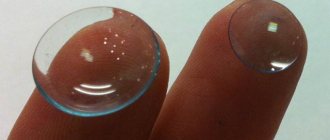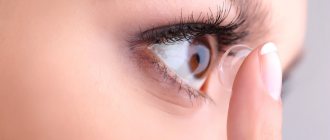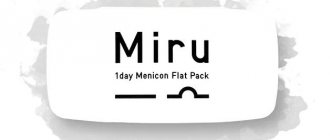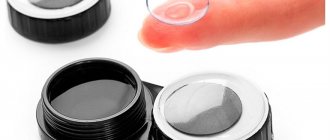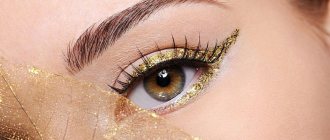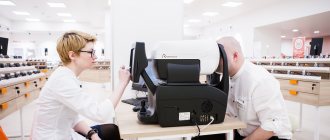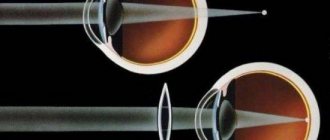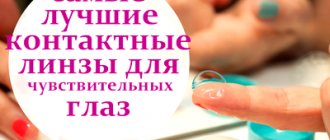Bausch+Lomb Optima FW
Optima FW lenses are made of durable silicone hydrogel material, which allows a sufficiently large amount of oxygen to pass through to the eye shell. This is necessary in order to avoid hypoxia. The moisture content of the material is low, but Optima FW contact optics are still convenient and comfortable to wear. These vision correction products are intended for daytime wear; before going to bed, they must be removed and placed in a disinfectant solution.
Since Optima FW lenses are manufactured using a centrifugal casting process, they guarantee excellent visual acuity for all users. Thanks to the use of this technique, all parameters are set with maximum accuracy, the lenses adhere perfectly to the eyes and, if necessary, are quickly centered.
Are quarterly contact lenses dangerous for the eyes?
What you definitely shouldn’t do in order to save money is buy cheap lenses from an unknown manufacturer, or make a purchase while running in a pedestrian crossing or on the street. Otherwise, with the correct selection of contact lenses from a world-famous brand, compliance with the wearing and care regimen for quarterly contact lenses, they are absolutely safe for your eyes.
Thus, Bausch&Lomb Optima FW contact lenses with a water content of 38.6% and an oxygen permeability index of 24.3 Dk/t provide sufficient oxygen supply to the eyes when worn during the day for 8-10 hours.
But if you prefer extended or continuous wear, choose from monthly or daily replacement silicone hydrogel lenses. For example, the same company Bausch&Lomb offers PureVision and PureVision 2HD lenses in its assortment.
With proper care using a multi-purpose solution and monthly use of special tablets to remove protein deposits, Optima FW contact lenses clean well and are therefore completely safe for the eyes and comfortable to wear.
As you can see, in general, quarterly scheduled replacement contact lenses are a very good and inexpensive option for contact correction that will give you all its advantages: convenience, inconspicuousness and the freedom to lead an active lifestyle while still having 100% vision.
Maxima 38 FW
Maxima products are famous for their excellent quality. Maxima 38 FW lenses are very thin, the disc thickness does not exceed 0.04 mm, through which oxygen freely flows to the eye shell. The moisture content is 38%, which guarantees that you will not experience the unpleasant feeling of dry eyes during use.
Maxima 38 FW are made using Cast Molding technology, which ensures a comfortable fit of products on the eyes due to the specific configuration of the edges and center.
What you need to know about such lenses
Quarterly lenses are a type of scheduled replacement lenses. They are prescribed for farsightedness, myopia and astigmatism. They can also serve a purely cosmetic (disguising iris imperfections) or decorative function (colored samples).
Such lenses are made from a safe and quite versatile material to use: hydrogel or silicone hydrogel.
Samples of such optics have many advantages. Among them:
- High strength of the material, preventing damage to the lens;
- High quality daily vision correction;
- A good degree of lens hydration, thereby avoiding the effect of eye fatigue;
- The presence of UV filters in some models allows you to protect the eyes of those people who lead a fairly active lifestyle and often spend time outdoors.
The choice of such products these days is very large. Both regular transparent samples and tinted or painted lenses are available for sale.
Speaking about the most popular lines of such products, suitable for the vast majority of patients, I would like to note the following:
- OPTIMA FW from the popular company Bausch + Lomb. Some of the highest quality and affordable models that suit the largest number of customers. They are only 0.035 mm thick, making them comfortable even for sensitive eyes. The products are also resistant to lipid accumulation and are therefore extremely easy to care for.
- Contact lenses BIOMEDICS 38 (SOFTVIEW 38) from CooperVision. These samples are distinguished by a specific double-convex design, thanks to which the most accurate fit of the product on the cornea is achieved. They provide a good level of moisture and are extremely resistant to mechanical and chemical influences.
BIOMEDICS 38 (SOFTVIEW 38)
- MAXIMA 38 FW from MAXIMA. This line provides maximum wearing comfort thanks to a high level of moisture, gas permeability, as well as innovative edge processing technology, which allows for the most comfortable fit of the lens to the eye.
- Korean SEASON line, which has increased resistance to moisture loss and the highest level of moisture content - 58%. In addition, the company provides, perhaps, the widest range of samples. Here you can find products up to -15 diopters.
Having understood the main characteristics of such lenses, as well as their range, let’s move on to considering the techniques for selecting and caring for the purchased samples.
Softview 38 and Biomedics 38 from CooperVision
CooperVision is an iconic figure in the quarterly optics segment. The lenses produced by this company are distinguished by their biconvex shape. They are not subject to deformation and have excellent resistance to all kinds of mechanical damage. Thanks to the high breathability of CooperVision lenses, they can be worn even in extended mode (which is quite rare for quarterly optics). But do not forget that switching to a prolonged wearing regimen without prior consultation with an ophthalmologist is not recommended. CooperVision lenses are extremely thin and have a sufficient level of moisture content, they will be comfortable and pleasant to wear, without dryness, itching or redness.
Quarterly contact lenses - features
Quarterly contact lenses are designed to last 90 days when worn only during daytime.
Such products come in both diopter and color, which perform exclusively decorative functions.
Quarter optics are soft and are made of silicone hydrogel or hydrogel.
When choosing such products, it should be taken into account that within three months they must be subjected to mechanical or enzymatic cleaning at least once or twice , since protein, fat and salt contaminants can accumulate on such models already in the first month.
Aquamax from Pegavision
Despite the fact that the cost of Taiwanese Aquamax lenses from Pegavision is quite low, the quality of vision correction products remains at a high level. Three-month lenses are made from reliable and comfortable-to-use polymacon material and are equipped with a special ultraviolet ray filter. They are an ideal option for those who plan to spend a lot of time outdoors and especially in the sun.
Tertia from Concor
For fans of domestic products, there are 3-month Concor lenses. They meet all international quality standards and are compatible with any solutions. In their production, only modern equipment and the latest technologies were used. Thanks to special methods of processing the surface and edges of the lenses, they fit tightly on the eyes and do not move even during active movements.
Contact lenses. My personal experience.
Good day to all). This is my first review, so please don't throw things around. I decided to share my personal many years of experience wearing contact lenses. Some points may be controversial in this mini-review, so please do not stomp your feet or become hysterical. This is just my personal experience. Welcome to cut
A little excursion into the past: I started reading around 4-5 years old, I read a lot and everything that caught my eye, and it’s no wonder that by the second year of high school I began to have vision problems. My parents, of course, played it safe and freed me (ugh) from half of the clubs and sections)). But how to wear glasses? You understand, in childhood and adolescence, almost all of us were embarrassed to wear glasses... unless at home and then only to watch TV. So they were embarrassed that by the age of twenty I had myopia of 3.5 diopters (moderate myopia, I think that’s what it was called).
In those Soviet times, there were no convenient cases or boxes for glasses like there are now, so glasses often broke, broke, bent, etc. And these plastic frames didn’t stand out much in design. And at the age of 20, I decided for the first time to buy such a strange and exotic thing as contact lenses. At that time they were not available in pharmacies or opticians. But I found it through an advertisement in a newspaper in some kind of joint German-Belarusian enterprise (JV). Since I knew exactly my vision and how many diopters, I just came to the office and bought my first reusable lenses.
It changed my whole way of life. To be honest, at first it took me a long time to learn how to “put them on” correctly and quickly. I figured it out with the pharmacy, they explained what solutions were needed to wash the lenses. It’s wild, of course, when compared with current technologies. And then we had to develop it almost like photographic film (developers, fixers...) - we washed it in the first solution, then in the second, and only then hid in our container (yes, there was a solution there too). These were reusable “weekly” lenses. That is, I wore it for a week (slept, bathed..), then took it off, washed it (it was a long time ago, I don’t remember exactly, I probably spent half an hour or an hour) and... again without taking it off for a week. It was not clear to me when I heard from people about intolerance to lenses or that they interfere with the eyes. (Maybe they turn them inside out accidentally and then yes, the edges of the lenses can be felt).
A few years later I saw beautiful chameleon glasses (with diopters) on sale and couldn’t resist. ... More than 10 years passed (and 3 glasses, may they rest in heaven :)) and the opportunity arose to return to the lenses, well, as it presented itself... in an instant the glass crumbled when falling on the concrete floor)) The search began, an urgent search There was no hope for medicine , since they sell people all sorts of crap at exorbitant prices, and there’s a waiting list for an appointment with an ophthalmologist... you can wait from 3 to 6 months.
... More than 10 years passed (and 3 glasses, may they rest in heaven :)) and the opportunity arose to return to the lenses, well, as it presented itself... in an instant the glass crumbled when falling on the concrete floor)) The search began, an urgent search There was no hope for medicine , since they sell people all sorts of crap at exorbitant prices, and there’s a waiting list for an appointment with an ophthalmologist... you can wait from 3 to 6 months. And in online optics, when placing an order, I checked the box that supposedly has a prescription for lenses, and after a couple days the package sits in your mailbox.
And in online optics, when placing an order, I checked the box that supposedly has a prescription for lenses, and after a couple days the package sits in your mailbox.
In general, I looked at several online stores in Western Europe, and the choice fell on this one: www.lentillesmoinscheres.com/ At that moment (2010) they sent the goods from a German warehouse (the order arrived in 3-5 days), now I receive it from French (delivery by regular mail in 2-3 days) www.lentillesmoinscheres.com/lentilles-de-contact/journalieres/lentilles-biomedics-1-day-30.html
In such a nice box (I peeled off the address sticker) 21cm*14.5cm*3cm
The packaging itself with lenses 15cm*5cm*3cm
The description states that these are: Soft contact lenses with a UV filter in a buffer solution. Contains: ocufilcon B 48%, H₂O 52% Manufacturer: CooperVision (UK, England) 30 pieces in one package, that is, 15 pairs. If someone has different diopters in each eye, then they order a package (30 pieces) with one data, and for the other - a second package with different parameters.
These same lenses are also available in other online stores, for example here: www.feelgoodcontacts.com/catalogue/biomedics www.feelgoodcontacts.com/contact-lenses/biomedics-1-day
With my “wrong” wearing of contact lenses, the packaging lasts for about a year. There are unforeseen cases, such as “getting dirty” or accidentally “flying off”. Sometimes I urgently need to repair something important (subminiature), then I also take it off, but having removed it, I have to immediately throw it away and put on new ones later.
Anticipating indignant comments about why I wear daily lenses for 20 days: if I felt even the slightest discomfort because of this, of course I would not wear them like that, but the real statistics of my vision - * by 1998 - was 3.5 diop (glasses) * from 1998 to 2009 - 4.5 (glasses) vision dropped by a whole diopter, since I worked with mobile phones for 6 years, I even had to take off my glasses to see better when soldering millimeter parts * from 2009 to 2018 ( in lenses) - 4.75 Yes, decreased by as much as (!!!) 0.25 diopt.
Well, excuse me, I work at the computer around the clock, and Photoshop doesn’t improve my vision. Of course, I no longer solder phones or motherboards for hours on end, but I turn on the soldering station and soldering irons every day.
They are easy to wear and I don't notice them at all. Sometimes I didn’t notice to such an extent that I forgot when I changed it. Therefore, I had to write down the date of the last change of lenses (I found it convenient to write it down directly on the inner lid of the package). The hard blue foil is difficult to remove and reveals the inner water world of Jacques Cousteau where the lens itself floats. To make it more convenient to remove the lenses from the container and place them on the edge of the fingertip (when putting the lenses on), I used 14cm tweezers for this task. Naturally, I put delicate cambrics on the tips so that the tweezers would not scratch the delicate material of the lenses. After many years of using this wonderful invention, I learned to put them on very quickly, on average it takes 2-5 seconds for each eye.
and here is the last purchase in September
But now I’m not afraid of rain, glass fogging, dust, I can use any sunglasses, you wake up and don’t have to look for glasses in the dark - after all, you can just look at the glowing clock in the distance. Yes, and it is very important that there are no such optical distortions as in glasses.
Good luck to everyone and take care of your health, including your eyes!
Season by OKVision
Season contact lenses for three months are produced by the Korean company OKVision. A distinctive feature of these vision correction products is the high level of moisture content in the material (as much as 56%, which is an order of magnitude higher than that of analogues). Thus, a sufficiently large amount of air is supplied to the cornea so that the eye does not experience oxygen starvation, and the cornea is constantly moisturized. You will be able to forget that you are wearing contact lenses.
Even if you work at a computer for a long time, or are constantly in a room with dry air (heated and/or air-conditioned), you will not suffer from the unpleasant symptoms of dry eye syndrome. In addition, thanks to the special technologies used in the production of Season optics, their surface is resistant to the formation of deposits (although this does not eliminate the need for preventive enzymatic cleaning). OKVision products have passed all necessary certification and quality testing procedures.
Adria Season by Interojo
A very young but promising company, Interojo, also produces quarterly optics under the Adria brand (Season model). Particularly noteworthy is the non-standard aspherical lens design, which avoids spherical aberrations and glare, which cause some discomfort to users of contact optics. Such products will be appreciated by car drivers - now at night the high beam headlights of passing cars will not cause so much inconvenience.
The edge of the lens is an order of magnitude thinner than that of analogues, this makes the process of putting it on simpler and more convenient, and unnecessary obstacles are eliminated when exchanging liquid in the space under the lens.
Ningaloo colored lenses
The Australian company Ningaloo produces several models of color contact optics. These are Ningaloo Gold and Ningaloo Sparkling. Shimmering dye (colloidal gold and its variations, mica, pigmented dyes) will become an additional preventative against all kinds of infectious diseases. The surface of the lens is particularly resistant to harmful deposits and allows sufficient air and moisture to pass through to the cornea. Ningaloo Gold will look especially impressive on dark eyes, giving them a luxurious, mysterious shine, and Ningaloo Sparkling will delight owners of light eyes. You don't have to worry that colored traces will remain on the white or iris - the dye is embedded deep in the disc material and will not get into your eye.
Adria colored lenses
The Interojo company pleases customers with a huge assortment of contact optics with a decorative effect. In the Adria line you can find colored lenses with a wear period of three months for every taste: natural shades, acidic and even carnival models with all sorts of unusual designs: cat's eye, smiley face, dollar sign and much more.
Wearing such products will be quite convenient and comfortable, but you should not use them for too long, and sleeping in quarterly replacement color optics is absolutely not recommended if you want to maintain eye health.
How to choose quarterly replacement products
If you decide to switch to quarterly optics, we recommend that you first consult an ophthalmologist. The doctor will examine you, conduct all the necessary tests, consult with you regarding your wishes regarding wearing regimen and other parameters, and then write a prescription. If you contact the Center for Contact Vision Correction, you will be able to try on various models of quarterly optics and evaluate how convenient and comfortable it is for you to wear them.
Independent selection of contact vision correction products can lead to deterioration of health and other unpleasant consequences.
Replacement frequency is the length of time a user can wear the same pair of lenses. But at the end of this period, you need to throw away the pair of lenses and start using a new one.
The replacement frequency can be divided into:
- One-day products, contact correction products used for one day.
- Biweekly - recommended replacement frequency is 2 weeks.
- Thirty-day glasses are contact optics that are worn for a month.
- Lenses that are worn for three to six months.
- Lenses that can be used all year long.
A long wearing period means that the contact optics will be packaged in bottles. Blister packaging offers a more frequent replacement period instead of bottle packaging.
Based on the frequency of replacement, lenses can be called one-day lenses, frequent scheduled replacement, scheduled replacement, traditional:
- One-day ones can be worn throughout the day. You cannot sleep in them, as they are designed for one-time use. In the morning, a person should put on a fresh pair of lenses and throw away the old one before going to bed in the evening. No maintenance required, and most importantly, eye health is maintained at the highest level. It is pleasant and convenient, safe and comfortable.
- frequently used for routine replacement . Their replacement period expires in two weeks. They are also quite safe for the eyes.
- Planned replacement lenses are worn for a month. This is also a short wearing period. In thirty days the material will not wear out much. The deposits, which certainly need to be cleaned, will not be able to accumulate to harm the eyes. This is the most common contact lens replacement regimen. Quarterly bills last for ninety days. This is the average period between short and long replacement periods. They need to be looked after, the date of purchase should be written down so as not to forget to buy new ones three months later.
- The longest replacement period is traditional . These contact correction products are worn for at least six months, and there are some that can be worn for a year. They are difficult to care for, since if a multifunctional solution is enough with all the previous types, then they need additional cleaning products. Over a long period of time, a lot of deposits will accumulate, the material will wear out, even if you take care of it, but with proper care there will be no harm to the eyes. You absolutely cannot sleep in such lenses; they are designed exclusively for daytime wear and are the most budget-friendly option for contact vision correction, which Europeans have almost eradicated, but which is still in demand in Russia.
